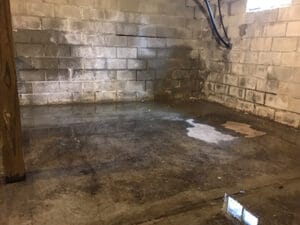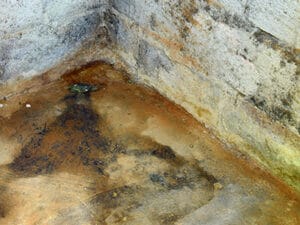Residential Basement Waterproofing Warning Signs
 If you are not sure about there being water in your basement, these are some of the most common basement waterproofing problem signs and symptoms. While the causes vary, they could be the result of a foundation problem or improperly set up drainage in the yard. If you notice any of them, please reach out to us to set up an appointment for one of our inspectors to evaluate your basement.
If you are not sure about there being water in your basement, these are some of the most common basement waterproofing problem signs and symptoms. While the causes vary, they could be the result of a foundation problem or improperly set up drainage in the yard. If you notice any of them, please reach out to us to set up an appointment for one of our inspectors to evaluate your basement.
Water Stains
While not every basement water stain is a serious issue, it is important to understand that there are different types of stains and each have their respective diagnosis and solution. Water stains can result from rust stains, dark mold stains, and efflorescence. While these different types of stains tell us different things, the common culprit is water intrusion.
Wet Walls
Wet walls in your basement is generally a sign of foundation water intrusion from a crack in the foundation wall and possible waterproofing system issues. There are several different repair solutions depending on the diagnosis of whether the root of the problem is a foundation issue or a waterproofing issue, or both.
Mold
Visible mold on paneling, drywall, and carpets is potentially the result of water penetration whether through foundation cracks or a failed waterproofing or drain system.
Condensation
 The warmer the air is in your basement, the more moisture it can hold. When this air is cooled it often has to release moisture. Condensation can develop when you have relatively warm, moist air contacting the cool surface of the walls causing droplets to form on your basement walls. Condensation is generally observed in a humid basement where their may not be proper insulation. There are several different repair solutions for condensation depending on the diagnosis of the issue.
The warmer the air is in your basement, the more moisture it can hold. When this air is cooled it often has to release moisture. Condensation can develop when you have relatively warm, moist air contacting the cool surface of the walls causing droplets to form on your basement walls. Condensation is generally observed in a humid basement where their may not be proper insulation. There are several different repair solutions for condensation depending on the diagnosis of the issue.
Wet Floor
A wet floor in your basement is generally a sign of foundation water intrusion from a crack in the foundation wall and possible waterproofing system issues. There are several different repair solutions depending on the diagnosis of whether the root of the problem is a foundation issue or a waterproofing issue, or both.
Efflorescence
Efflorescence is the migration of a salt to the surface of the concrete where it forms a coating. The process involves the dissolving of an internal salt in the concrete in water. The water migrates to the surface and evaporates, leaving behind a coating of salt. Efflorescence on concrete walls is a sign that water is entering the walls and will cause further deterioration of the concrete and steel reinforcement. Foundation repair along with basement waterproofing is generally warranted.
Sump Pump Issues
Sump pumps are designed to eject water from around and below your foundation to the exterior and away from the foundation. When sump pumps fail or aren’t functioning properly they can lead to a variety of problem signs including foundation settlement, water on the floor, walls, and mold in your basement.
Musty Smell
Musty odors in your basement can be caused by a number of things, but generally are signs of mold and mildew build up. The foul smell is caused by mold and mildew building up and releasing nasty gasses. There are several different solutions depending on the diagnosis of the root of the problem issue.
Iron Ochre
Iron ochre is a mineral deposit that forms in soil and groundwater, primarily composed of iron oxide minerals, such as hematite or goethite. It typically appears as a thick reddish-brown or yellowish-brown gelatinous substance and can occur naturally in various environments where iron-rich minerals are present.
In geographical areas with high concentrations of iron ochre, it can cause issues such as staining of surfaces, clogging of drainage systems, and contamination of water supply. It’s often located within regions where iron-rich bedrock is present or where iron-containing minerals have leached into the surrounding soil and water.
Effects of Iron Ochre on Drainage Systems:
- Pipe Blockages: Iron ochre can build up inside drainage pipes, forming thick layers that can restrict or completely block the flow of water. This can lead to flooding and sewage backups into homes or buildings.
- Reduced Drainage Capacity: Even if iron ochre doesn’t completely clog the pipes, it can still significantly reduce their cross-section, limiting the drainage capacity of the system. This can cause the slowing of draining fixtures, pooling water, and other drainage problems.
- Odor: Iron ochre often produces odors, similar to rotten eggs, due to the presence of sulfur compounds produced by the bacteria of its formation. These odors can be noticeable both inside and outside of buildings affected.
- Corrosion: Iron ochre can promote corrosion of metal components in drainage systems, such as pipes, fittings, and sump pumps. This corrosion can weaken the pipes, leading to leaks, further blockages, and ultimately the need for repairs or replacement.
- Septic System Problems: In septic systems, iron ochre can clog drain fields, reducing their flow and effectiveness in treating wastewater. This can result in septic system failures, with sewage backing up into the home or building, and contaminating the surrounding soil and water sources.
Overall, iron ochre can cause substantial damage and functional problems with drainage systems, requiring costly repairs and maintenance. Preventative measures such as regular inspections, cleaning, and treatment may be necessary to mitigate its effects
Solutions
If you see any of the problems we’ve described here in your basement, there is no cause for panic. Our team specializes in providing homeowners with solutions to basement water issues. Please follow the link below to get more information about our basement waterproofing solutions.
Contact Us
If you’ve got any type of water problem in the basement, please contact us today to set up an appointment with a member of our team to investigate the problem and come up with the best repair solution for you.